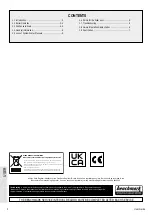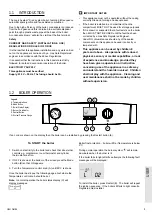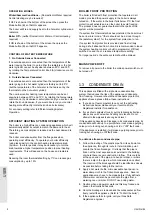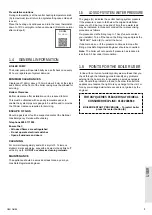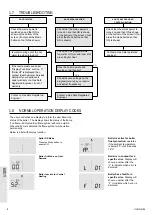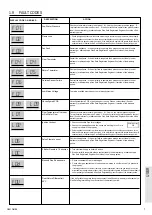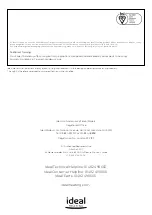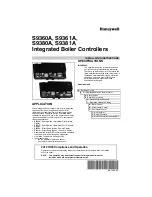
4
User Guide
USER
OPERATION MODES
Winter/Summer Conditions –
(Domestic Hot Water required,
Central Heating may be required)
If OFF is shown at the bottom of the screen then press the
Mode button (B) so that ON appears.
The boiler will fire and supply heat to the hot water cylinder and
radiators.
Boiler Off –
(neither Domestic Hot Water or Central Heating
required)
If ON is shown at the bottom of the screen then press the
Mode button (B) so that OFF appears.
CONTROL OF WATER TEMPERATURE
1. No Outside Sensor Connected
If no outside sensor is connected then the temperature of the
water leaving the boiler to go to either the radiators or the hot
water cylinder can set be anywhere between 80°C and 30°C
by rotating the Temperature Control Knob (A) clockwise or anti-
clockwise.
2. Outside Sensor Connected
If an outside sensor is connected then the temperature of the
water going to the hot water cylinder is factory set to 80°C
(but the temperature of the hot water to the tap is set by the
thermostat on the hot water cylinder).
The nominal central heating room temperature can be set
anywhere between 30°C and 10°C by rotating the Temperature
control knob (A) clockwise or anti-clockwise (if you are too cold
rotate the knob clockwise, if you would like to run your central
heating more efficiently rotate the knob anti-clockwise).
For economy setting refer to Efficient Heating System
Operation.
EFFICIENT HEATING SYSTEM OPERATION
The boiler is a high efficiency, condensing appliance which will
automatically adjust its output to match the demand for heat.
Therefore gas consumption is reduced as the heat demand is
reduced.
The boiler condenses water from the flue gases when
operating most efficiently. To operate your boiler efficiently
(using less gas) turn the central heating temperature knob
(A) lower. In winter periods it may be necessary to turn the
knob towards a higher temperature position to meet heating
requirements. This will depend on the house and radiators
used.
Reducing the room thermostat setting by 1ºC can reduce gas
consumption by up to 10%.
BOILER FROST PROTECTION
The boiler is fitted with frost protection that operates in all
modes, provided the power supply to the boiler is always
turned on. If the water in the boiler falls below 5ºC, the frost
protection will activate and run the boiler to avoid freezing.
The process does not guarantee that all other parts of the
system will be protected.
If a system frost thermostat has been installed, the boiler must
be set in winter mode, “(there should not be a cross through
the radiator symbol)”, for the system frost protection to run.
If no system frost protection is provided and frost is likely
during a short absence from home it is recommended to leave
the system heating controls or built in programmer (if fitted)
switched on and run at a reduced temperature setting.
For longer periods, the entire system should be drained.
MAINS POWER OFF
To remove all power to the boiler the mains power switch must
be turned off.
1.3 CONDENSATE DRAIN
This appliance is fitted with a siphonic condensate trap
system that reduces the risk of the appliance condensate
from freezing. However should the condensate pipe to this
appliance freeze, please follow these instructions:
a.
If you do not feel competent to carry out the defrosting
instructions below please call your local Gas Safe
Registered installer for assistance.
b.
If you do feel competent to carry out the following instructions
please do so with care when handling hot utensils. Do not
attempt to thaw pipework above ground level.
If this appliance develops a blockage in its condensate pipe, its
condensate will build up to a point where it will make a gurgling
noise prior to locking out, showing an
L
0
d or “
LO2
” fault code.
If the appliance is restarted it will make a gurgling noise prior to
locking out, showing an
LO2
fault code.
To unblock a frozen condensate pipe;
1.
Follow the routing of the plastic pipe from its exit point on
the appliance, through its route to its termination point.
Locate the frozen blockage. It is likely that the pipe is
frozen at the most exposed point external to the building
or where there is some obstruction to flow. This could be
at the open end of the pipe, at a bend or elbow, or where
there is a dip in the pipe in which condensate can collect.
The location of the blockage should be identified as closely
as possible before taking further action.
2.
Apply a hot water bottle, microwaveable heat pack or a
warm damp cloth to the frozen blockage area. Several
applications may have to be made before it fully defrosts.
Warm water can also be poured onto the pipe from a
watering can or similar. DO NOT use boiling water.
3.
Caution when using warm water as this may freeze and
cause other localised hazards.
4.
Once the blockage is removed and the condensate can flow
freely, restart the appliance. (Refer to “To Start the boiler”)
5.
If the appliance fails to ignite, call your Gas Safe
Registered engineer.


